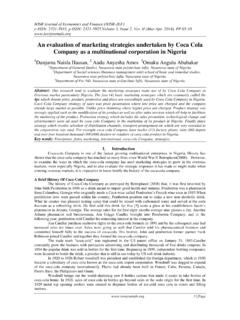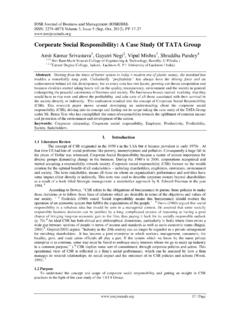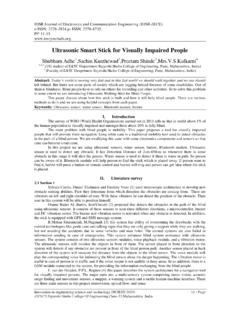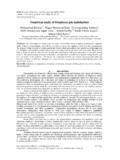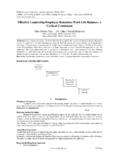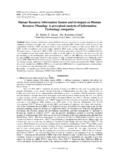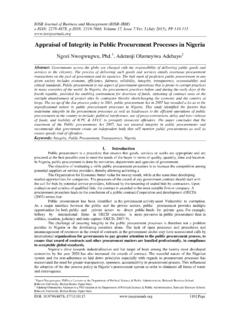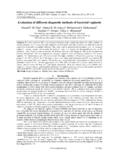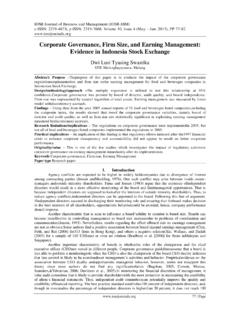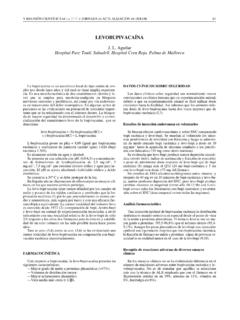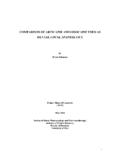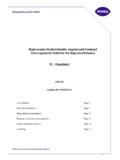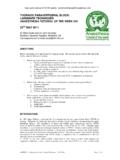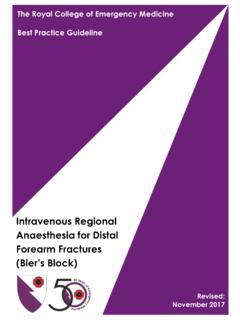Transcription of A case of Inherited Unconjugated …
1 IOSR Journal of Dental and Medical Sciences (IOSR-JDMS) e-ISSN: 2279-0853, p-ISSN: 2279-0861. Volume 11, Issue 1 ( Dec. 2013), PP 17-20 17 | Page A case of Inherited Unconjugated Hyperbilirubinemia foran incidental surgery: Anesthetic management and Review Namasivayam1, 1, , 1 , Medical College & Hospital, Chennai, India Biochemistry, SreeBalaji Medical College & Hospital, Chennai, India Abstract:Congenital indirecthyperbilirubinemiaoccurs due to the relative deficiency or absence of the primary conjugating enzyme enzyme UDP glucuronyltransferase is responsible for the conjugation of bilirubin in liver.
2 The enzyme is also essential for transport of many other substrates including drugs, hormones, toxins and neurotransmitters. Thus, anaesthetic management of such a case is quite challenging. Avoiding drugs which use this enzyme for its metabolism or excretion during the perioperative period allows safe conduct of anaesthesia for these patients. We report a case of Inherited Unconjugated hyperbilirubinemiafor an incidental surgery and review the different types of congenital indirect hyperbilirubinemias.
3 Keywords:Anaesthesia, bilirubin,inheritedunconjugated hyperbilirubinemia, Crigler-Najjar syndrome, Gilbert syndrome I. Introduction Inherited unconjugatedhyperbiliruninemias are rare hereditary disorders of bilirubin conjugation usually diagnosed by exclusion, in the absence of overt hemolysis or liver disease. Bilirubin is conjugated into a more soluble form by the enzyme UDP-glucuronyltransferase[1].Many anaesthetic drugs are metabolized in the liver via conjugation by the same enzyme. Hereditary deficits in this enzyme system can potentially affect the metabolism of these drugs leading to adverse outcomes.
4 Despite this significance, reports on anaesthetic management of patients with Inherited unconjugatedhyperbilirubinemia syndrome are few. II. Case History A 25 year old, 50 kgmale patient, presented with abdominal pain and vomiting for one week. Patient had similar complaints ten months back for which he was evaluated and found to have a colonic mass. He had undergone limited resection anastomosis in some other hospital. Biopsy proved to be adenocarcinoma and patient underwent six cycles of chemotherapy. Post-operative period was uneventful.
5 Patient had history of yellowish discoloration of eyes since childhood and yellowish discoloration of urine on and off. Patient was evaluated during childhood for jaundice but he did not follow up and so no other details were available regarding the work up. The present investigations revealed normal complete blood count and renal function test. LFT showed total bilirubin md/dl, Direct bilirubin mg/dl,Indirect bilirubin mg/dl,AST 42 IU/L,ALT 60 IU/L,ALP 102 IU/L,GGT 7 IU/L,Total protein g/dl, g/dl, globulin g/dl,PT16 sec, and aPTT 26 sec.
6 Viral markers were Abdomen showedno significant abnormality. Colonoscopy showed post limited resection end to end anastomosis transverse colon status and otherwise normal study Peripheral smear showed normocytic normochromic RBCs and a reticulocyte countof 1%. Hematologist opinion was obtained which suggested aninherited Unconjugated hyperbilirubinemia and advised to rule out hemolysis and Wilson s disease correlating with a CECT gastro enterologist opined on aninherited unconjugatedhyperbilirubinemia most probably Gilbert syndrome or Criggler Najar syndrome.
7 Other differential diagnoses were immune hemolytic anemia and Wilson s disease. Serum ceruloplasmin, serum copper and LDH values were within normal limits. Subacute intestinal obstruction due to adhesions was the provisional diagnosis. Laparoscopic adhesiolysis was planned. Patient was assessed under ASA PS II and was accepted for anaesthesia with added risk. Four units offresh frozen plasma were transfused and three doses of Inj. vitamin K givenpreoperatively. The repeated INR was Preoperative vitals were within normal limits.
8 Premedication was with Inj. Glycopyrollate , Inj. Midazolam 1 mg and Inj. Fentanyl patient waspreoxygenated with 100 % O2 for 3minutes and induced with Inj. Propofol 100mg and Atracurium 30mg. Airway was secured with a size 8cuffed endotracheal tube. Patient was connected to circle system and maintained with N2O: O2 2: 1 and Isoflurane 1%. Intra operative period was operatively after spontaneous respiratory attempts, patient was A case of Inherited Unconjugated Hyperbilirubinemiaforan incidental surgery: Anesthetic 18 | Page reversed with inj.
9 Neostigmine mg and inj. Glycopyrollate mg. Patient was extubatedafter thorough suctioning. Immediate post-operative period was uneventful. Post-operative liver function tests were similar to the pre-operative with no significant deterioration of liver function. Patient was observed for five days for untoward events and discharged with advice to follow up in surgery, medical gastroenterology and hematology department. III. Discussion Three familial disorders have been recognized reflecting differing degrees of deficiency in the ability to conjugate bilirubin namely, Gilbert syndrome,Crigler-Najjar syndrome type I andCrigler-Najjar syndrometype II[1].
10 Augustine Gilbert and Pierre Lereboullet first described the Gilbert syndrome[2], the most common Inherited cause of Unconjugated hyperbilirubinemia, in 1901. This autosomal-recessive condition is characterized by intermittent jaundice due to under activity(10-30% of normal)of UridineDiphosphateGlucuronylTransferase[ 1].At least 30% of the patients are asymptomatic, although nonspecific symptoms, such as abdominal cramps, fatigue and malaise, are is mild(less than 4mg/dl) and the most commonly performed laboratory studies like peripheral blood smear and lactate dehydrogenase (to rule out hemolysis) and liver function tests (with the exception of Unconjugated hyperbilirubinemia), arenormal.
